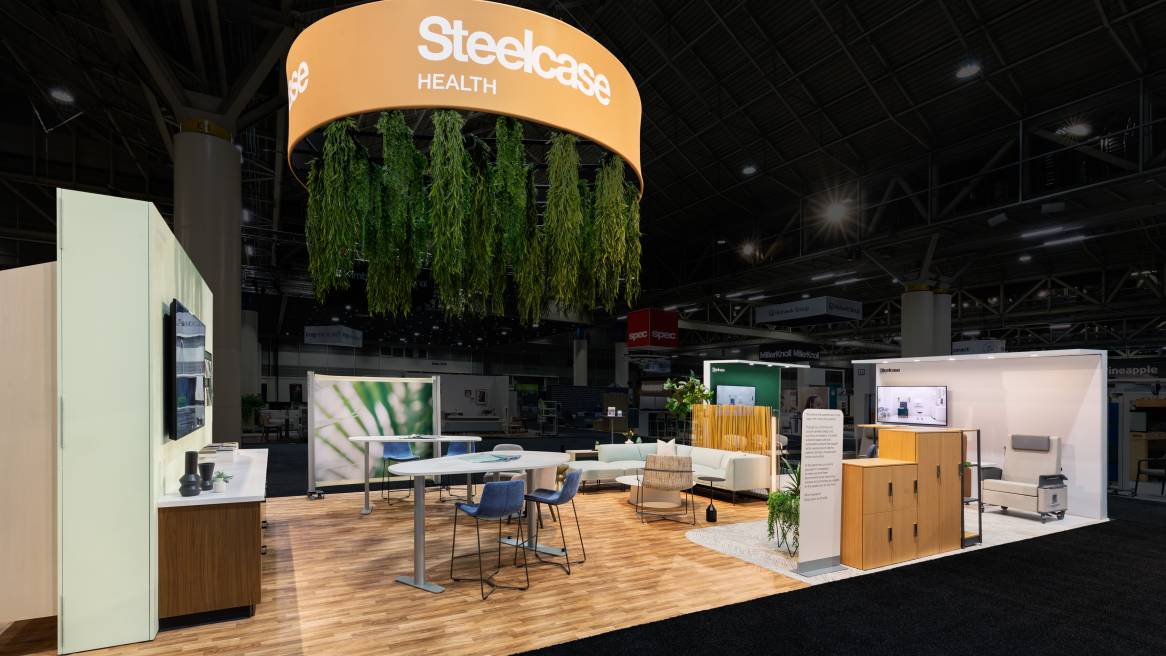New Perspectives From the Healthcare Design Community
Steelcase designers + researchers explore new trends and solutions at the Healthcare Design Conference + Expo
The Healthcare Design Conference + Expo draws thousands of people from around the world, showcasing the newest and most innovative healthcare design solutions and services in the healthcare industry. With hundreds of educational sessions, exhibits, panel discussions and presentations, the conference aims to highlight the best research-based practices and top healthcare products as the industry looks to the future.
This year, conference guests experienced a curated tour of the Steelcase Health exhibit, which included new product solutions, planning ideas and material innovations from Steelcase and brand partners Designtex, West Elm, KwickScreen and Moduform.
Steelcase Health asked seven of our healthcare experts to immerse in the three-day event and summarize their key takeaways – in an effort to better understand the latest trends and product innovations in healthcare design.
Design for Accessibility, Inclusion and Safety

For Steelcase Health Design Manager Beth Bronson, the interconnectivity between the environment, social justice, health equity, and resilience was a key takeaway. She says designers have a social responsibility to take these important factors into consideration as we create healthcare spaces, in order to help patients-and communities-achieve optimal health. Designers need to think beyond ‘just buildings’; we need to focus on how to help alleviate stress and build resilience by creating environments that provide a wellness intervention for patients, family and staff, through holistic design that addresses physical, cognitive, social and emotional wellbeing.
“We need to ask ourselves, how can we create spaces that are welcoming and inclusive to all? Consider accessibility, safety, and availability. Take into consideration spaces that are regenerative through active design, while allowing for pause and reflection when needed.”
BETH BRONSON | Health Applications Design Manager, Steelcase Health

While a space should support wellbeing in a variety of ways, safety is always a paramount concern. Steelcase industrial designer Vineta Chugh says she was impressed with the dialogue in the educational sessions about designing for physical and psychological safety – which are incredibly important in addressing the needs of the most vulnerable or marginalized communities.
“As a designer, it’s crucial to incorporate details that evoke a sense of safety, familiarity, calmness, and support for individuals in high-performing and fast-paced healthcare spaces. This approach enables me to anchor the designs and make deliberate choices in crafting forms and materials that contribute to a softer, warmer, and more welcoming space.”
VINETA CHUGH | Industrial Designer, Steelcase Health
Design for Flexibility

Flexibility is the future when it comes to the office, and that notion is no different for healthcare environments. Steelcase Healthcare Account Manager Annette Klaus says she came away from the expo with a reinforced idea that the need for standardization with adaptability is a leading trend in the future of healthcare design. Utilizing modular solutions for standards to fit, flex and adapt in ever-evolving care environments allows for a consistent experience, branded look, and high level of performance across departments, campuses and regions.
“Standardization is increasingly important at every scale of a project to maximize cost and efficiency, but in order to be successful, there must also be a level of adaptability assumed throughout each phase of the project.”
ANNETTE KLAUS | National Healthcare Account Manager, Steelcase Health

How climate change is forcing health systems to think more seriously about flexibility in much broader terms was an emerging trend that caught the attention of Seth Starner, Advanced Explorations leader at Steelcase Health. In the past, flexibility was often viewed as a key consideration for disaster preparedness and being able to quickly convert spaces to handle a limited mass-injury event. Over the past few years however, climate change is getting the attention of administrators and forcing conversations and actions to manage for inevitable climate change events – whether that be more intense hurricanes, more frequent and larger tornadoes, or flooding. These events not only threaten the wellbeing of the community but also directly affect the hospital’s ability to function.
“This requires a much more advanced level of flexibility where administrators can’t possibly predict all the potential problems and therefore need facilities that are highly adaptable. So the central question becomes, how might we continue to support flexibility and adaptability in the built environment to help hospital systems be prepared for climate change in general and for specific large-scale climate change driven events?”
SETH STARNER | Advanced Explorations, Steelcase Health

Flexibility was a major theme that extended into building architecture as well. Embracing the reality of extremely dynamic healthcare spaces in a world of increasing volatility was a key takeaway for Steelcase Industrial Design Manager John Allen.
“Planners are embracing the need for constant change and prioritizing reconfiguration of spaces at many different scales. An increasingly uncertain environment will put pressure on manufacturers and healthcare providers to think about flexibility in new ways.”
JOHN ALLEN | Industrial Design Manager, Steelcase Health
Materials, Design and Function
![]()
In the realm of healthcare materials, the fusion of design and function remains paramount. Crafting environments that seamlessly blend easy maintenance, disinfection, and hygiene support, fosters a sense of calmness, safety and assurance. By prioritizing both aesthetics and thoughtful engineering, Sara Balderi, Designtex design director, believes that design can elevate the experience for staff, patients and their loved ones.
“As material designers, our mission is clear: Offer a myriad of visually engaging options while engineering for performance and sustainability.”
SARA BALDERI | Design Director, Designtex

While the analog properties of materiality are essential, advanced technology like AI is becoming an increasingly vital trend in healthcare. Katie VanWagner keyed in on identifying the challenges of today’s healthcare system, and how AI can influence patient outcomes. Currently, the U.S. system of healthcare is based on reactionary care versus proactive care. However, with AI, research articles are more quickly synthesized, design tools and software are steadily developing, and healthcare tests and tools are generating predictive health models that can better serve patients. In these ways, AI can help not only avoid some of the 250,000 deaths from medical error each year, but transpose the model to one rooted in proactive care. That advanced infrastructure needs to be supported by the built environment.
“We must start measuring clinical, social, organizational, and procedural outcomes to design efficient and successful healthcare spaces moving forward.”
KATIE VANWAGNER | Health Applications Senior Designer, Steelcase Health
Experience Our Spaces
We invite you to take the next step toward creating your ideal healthcare spaces and experiences. Connect with us to schedule an expert-guided virtual tour of our newest spaces for healthcare from waiting spaces to patient rooms, and everything in between.


